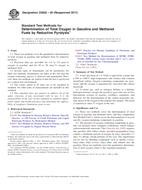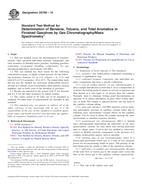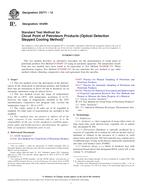Wir benötigen Ihre Einwilligung zur Verwendung der einzelnen Daten, damit Sie unter anderem Informationen zu Ihren Interessen einsehen können. Klicken Sie auf "OK", um Ihre Zustimmung zu erteilen.
ASTM D7872-13
Standard Test Method for Determining the Concentration of Pipeline Drag Reducer Additive in Aviation Turbine Fuels
Automatische name übersetzung:
Standard Test Methode zur Bestimmung der Konzentration der Pipeline Drag Reducer Additive in Aviation Turbine Fuels
NORM herausgegeben am 15.6.2013
Informationen über die Norm:
Bezeichnung normen: ASTM D7872-13
Anmerkung: UNGÜLTIG
Ausgabedatum normen: 15.6.2013
SKU: NS-39213
Zahl der Seiten: 5
Gewicht ca.: 15 g (0.03 Pfund)
Land: Amerikanische technische Norm
Kategorie: Technische Normen ASTM
Kategorie - ähnliche Normen:
Die Annotation des Normtextes ASTM D7872-13 :
Keywords:
DRA, GPC, jet fuel, rotary evaporation, total exclusion, ICS Number Code 75.160.20 (Liquid fuels)
Ergänzende Informationen
| Significance and Use | ||||||
|
5.1 DRA is frequently added into multiproduct pipelines to increase throughput or reduce energy requirements of fuel movement. Although these additives are not used in jet fuel, contamination can occur from other products if proper batching guidelines are not followed or by other cases of human error. CRC Report No. 642 reviewed the impact of DRA on jet fuel fit-for-purpose performance and concluded that the fuel spray angle and atomization capability of several engine-type fuel nozzles can be adversely affected impacting high altitude relight performance at elevated concentrations. A method that accurately quantifies the amount of DRA in jet fuel can be useful in confirming the absence of significant contamination to protect the safety of aviation operations. This test method is designed to measure down to sub-100 µg/L levels of DRA in aviation fuel. |
||||||
| 1. Scope | ||||||
|
1.1 This test method covers the measurement of high molecular weight polymers, in particular pipeline drag reducer additive (DRA), in aviation turbine fuels with a 72 µg/L lower detection limit. The method cannot differentiate between different polymers types. Thus, any non-DRA high molecular weight polymer will cause a positive measurement bias. Further investigation is required to confirm the polymer detected is DRA. 1.2 The values stated in SI units are to be regarded as standard. No other units of measurement are included in this standard. 1.3 Warning—Mercury has been designated by many regulatory agencies as a hazardous material that can cause central nervous system, kidney and liver damage. Mercury, or its vapor, may be hazardous to health and corrosive to materials. Caution should be taken when handling mercury and mercury containing products. See the applicable product Material Safety Data Sheet (MSDS) for details and EPA’s website — http://www.epa.gov/mercury/faq.htm — for additional information. Users should be aware that selling mercury and/or mercury containing products into your state or country may be prohibited by law. 1.4 This standard does not purport to address all of the safety concerns, if any, associated with its use. It is the responsibility of the user of this standard to establish appropriate safety and health practices and determine the applicability of regulatory limitations prior to use. |
||||||
| 2. Referenced Documents | ||||||
|
Ähnliche Normen:
Historisch
1.5.2011
Historisch
15.1.2014
Historisch
1.6.2014
Historisch
1.12.2012
Historisch
1.5.2010
Historisch
15.4.2012
Empfehlungen:
Aktualisierung der technischen Normen
Wollen Sie sich sicher sein, dass Sie nur die gültigen technischen Normen verwenden?
Wir bieten Ihnen eine Lösung, die Ihnen eine Monatsübersicht über die Aktualität der von Ihnen angewandten Normen sicher stellt.
Brauchen Sie mehr Informationen? Sehen Sie sich diese Seite an.



 ASTM D5622-95(2011)..
ASTM D5622-95(2011).. ASTM D5623-94(2014)..
ASTM D5623-94(2014).. ASTM D5705-14
ASTM D5705-14 ASTM D5708-12
ASTM D5708-12 ASTM D5769-10
ASTM D5769-10 ASTM D5771-12
ASTM D5771-12
 Cookies
Cookies
